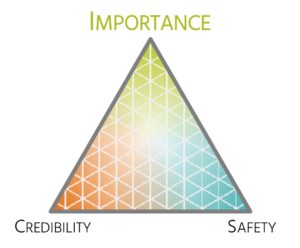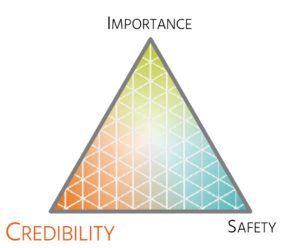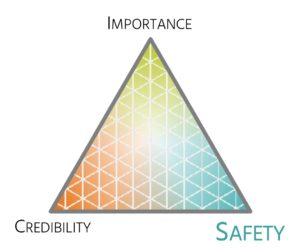
Trusting Collaborations are Vital to the Success of Your Innovation
Success in today’s complex Innovation landscape demands multi-discipline collaborations that require more participants, that come with a wider range of capabilities and a rich diversity of motives. Whether it is pooling information and knowledge across multidisciplinary teams or public–private partnerships, getting all the contributors working well together in an effective innovation ecosystem is essential. Poor collaborations are not in anyone’s interest and often not realised until some way down the track. A waste of valuable time and resources for all concerned.
In my previous blog I posed the question: How do you do trust? The blog offered a point of view to encourage a more conscious focus on building this key component of collaborations. This blog continues that theme and points to other aspects of building trust that would benefit from our attention.
For many trust builds natural and gradually taking time to develop. It can also go through a step change and made more tangible through an individual or group coming through a ‘crisis’ and been seen to do the right thing. Sometimes referred to as the ‘diving catch’ that saves the day. Although this can feel reassuring once you are on the right side of the ‘crisis’, it would imply that we have to wait until these ‘crises’ come before we really trust each other. Maybe there is another way beyond the ‘diving catch’.
A big part of Cambium’s success in accelerating partnering for innovation for our clients depends on catalysing effective collaborations. We pay a lot of attention in building and maintaining trust and our experience points to 3 elements vital in the trust building process. Our experience also highlights that very often, individuals and teams only pay attention to 1 or 2 of these 3 elements. This is OK to a degree if the collaborators are all paying attention to the same one or two elements. Where there is a mismatch, the development of trust is much slower and may stall altogether.
 The first element is Importance. Regardless of the strength of you or your collaborators capabilities, the investment in the relationship will be limited by the priority each organisation puts on the potential value of the outcomes. Not always obvious at first, but the cracks start appearing where other priorities start to create slippage on earlier mutually agreed plans. Here it is useful to look beyond the immediate outcomes of a project, to see where this leads to and the degree of “fit” with the strategic goals of each of the collaborators. In the longer term how important is this collaboration to each the partners?
The first element is Importance. Regardless of the strength of you or your collaborators capabilities, the investment in the relationship will be limited by the priority each organisation puts on the potential value of the outcomes. Not always obvious at first, but the cracks start appearing where other priorities start to create slippage on earlier mutually agreed plans. Here it is useful to look beyond the immediate outcomes of a project, to see where this leads to and the degree of “fit” with the strategic goals of each of the collaborators. In the longer term how important is this collaboration to each the partners?

A second element is Credibility and is associated with brand and reputation. It relates to how the well each collaborator sees the other’s capability at the start of the relationship. For example, some organisations will only collaborate on research with prestigious universities, while some SME’s will be wary of working with certain large enterprises that they perceive as predatory. One thing to consider here, organisations tend to think their own brand is stronger than it is perceived by others. If your organisation is one that has lots of ‘promising’ partner conversations that never amount to anything beyond an NDA, then it may be worth checking out how your own perceptions to fit with how other potential partners rate you.
 The third area, Safety represents the things we do or don’t do as part of our ways of working together once the collaboration has started. It includes ‘hygiene’ factors like being on time for meeting and making sure actions, however small, are followed up. It also includes the less visible cultural norms like how issues are escalated and levels of autonomy / democracy in decision making. In our real-world busy lives, not all the ‘hygiene’ factors get attended to and it is almost inevitable that we will ‘transgress’ someone else’s cultural norms. Knowing that this stuff happens is useful so having mechanisms to accommodate and work through these ‘transgressions’ is key to building trust.
The third area, Safety represents the things we do or don’t do as part of our ways of working together once the collaboration has started. It includes ‘hygiene’ factors like being on time for meeting and making sure actions, however small, are followed up. It also includes the less visible cultural norms like how issues are escalated and levels of autonomy / democracy in decision making. In our real-world busy lives, not all the ‘hygiene’ factors get attended to and it is almost inevitable that we will ‘transgress’ someone else’s cultural norms. Knowing that this stuff happens is useful so having mechanisms to accommodate and work through these ‘transgressions’ is key to building trust.
Over time and engaging with individuals and groups from a wide range of disciplines and working cultures, Cambium has been constantly gathering information that helps build, grow and maintain trust in new and established teams. We have worked with commercial innovators from global enterprises to early stage businesses, as well as national research laboratories and academics. Our approach and knowledge has been taken time to accumulate, but has been essential in our work in developing smarter innovations.
It is this tried and tested experience in trust acceleration and management that is an integral part of the toolset that underpins our engagement processes, for Collaborative Innovation and New Market Anticipation






